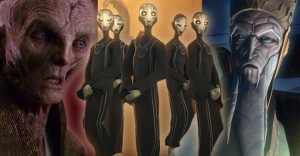10 Best Horror Games That Have A Cute Art Style

True fear comes from the disconnect between what a person expects and what actually happens in reality. For example, seeing people at a crowded intersection isn’t scary, but seeing a lone person in what should be a deserted alley is terrifying. Rather than necessarily being afraid of the person themself, the horror originates from the person being an unexpected variable in that particular scenario.
Because of this, horror games primarily scare players by subverting their expectations. Some games do this by having a cute art style that contrasts with the scary elements. But which games masterfully hide the true terror beneath an adorable veneer?
Pink

One of the many great indie horror games available on Itch.io is the short pixel horror game Pink. Released for free in 2020, the game follows an unnamed woman who lives alone in her studio apartment, which is almost entirely pink because that’s her favorite color. Throughout her home, she has multiple potted plants that she waters and takes care of.
Despite the cheery decor and the primary gameplay being centered around cultivating plants, the player immediately realizes that something is wrong when the protagonist refuses to leave her apartment. Over the couple of in-game days, it quickly becomes apparent that this is a post-apocalyptic world, and the protagonist’s time is almost up.
A Pet Shop After Dark

Developed by indie developer npckc, who also created the Spring-focused trilogy A Year of Springs, A Pet Shop After Dark is a free visual novel meta horror game. Created for the game jam “Summer Slow Jams August 2020: Horror Games,” this game follows an unnamed woman who is hired to watch over a strange pet shop while the owner is away.
Before leaving, the owner gives the protagonist three rules: she must water the plants, feed the seemingly invisible animals, and never turn off the lights. Although the game appears to be a simple visual novel at first, the player eventually realizes that they will need to manipulate the game’s files in order to uncover the mysteries behind the shop.
Confess My Love

Released on Steam in 2017, Confess My Love is a freeware horror experience that follows a boy named Willie who is struggling to confess his love for his fellow classmate Liza. When Willie wakes up after seemingly falling asleep in class, he discovers that school is over for the day and Liza is one of the only other students left in the classroom, which means that now might be the perfect time to tell her how he feels.
Like most horror games that don’t seem like horror games at first, the first playthrough, which only lasts a couple of minutes, is mostly harmless and comedic as Willie fails regardless of his choice. But, the player is supposed to keep replaying to obtain all 20 endings, and each subsequent playthrough introduces new elements that slowly reveal this title’s hidden darkness.
Adventures In In In In

Created for the game jam “RPG Paper Maker Jam 2,” Adventures In In In In is a short horror game released in 2021. After waking up in the middle of a forest with no memory of how they got there, a mouse NPC tries to simply return home only to discover that the hero, Fluffy, and the rest of the world are slowly getting corrupted by glitches.
To save their village, the hero, and the entire in-game world, the mouse must go on a quest to defeat the source of the corruption and restore the world to its original state. But, as a part of the game’s data, this task is easier said than done.
Strange Telephone

Inspired by the influential horror game Yume Nikki, Strange Telephone is a 2019 surreal adventure game that follows a woman named Jill who is trapped behind a large door. With the aid of a strange being named Graham, who takes the form of an old phone, Jill can call any six-digit number, which transports her to various worlds.
As she navigates the dream-like worlds, Jill will find items and clues that can possibly lead to her escape. With multiple endings, events, and secrets, the player is encouraged to explore and slowly piece together the hidden narrative within the game.
Dreaming Sarah

Another great game that is directly inspired by Yume Nikki is Dreaming Sarah, which is a 2015 adventure platformer about a young girl in a coma named Sarah. To help her wake up, the player must guide Sarah through her dream world, talk to interesting NPCs, and solve puzzles.
As Sarah discovers various items, such as the Umbrella and the Shell Necklace, she will slowly unlock more areas to explore. Depending on what the player finds, they will obtain one of two endings.
Fausts Alptraum

Inspired by German playwright Johann Wolfgang von Goethe’s Faust, Fausts Alptraum is a free RPG Maker horror game about a young girl named Elisabeth Faust whose father recently died. While visiting the gothic mansion her father left behind for her, she follows a black cat into the basement and meets a demon named Mephistopheles, who greets her like an old friend. When Elisabeth tries to leave the house, she discovers the door has vanished and her aunt has disappeared.
To escape the house, Elisabeth makes a deal with Mephistopheles that the demon will let her find the exit by playing the demon’s game. If she is able to explore the house and navigate all the challenges, then she’ll be free, but the catch is that Elisabeth cannot feel nostalgic about the place for even a moment or she’ll be trapped there forever. The game’s Tim Burton storybook-esque aesthetic and surreal story creates a unique experience that will keep players intrigued until the very end.
LiEat

Created by Miwashiba, who also developed other beloved RPG Maker titles such as 1BitHeart and the Alice in Wonderland inspired Alicemare, LiEat is an adventure RPG that takes place in a universe where dragons are born from the desires of humans. Originally released separately for free as three short chapters, players can now purchase the trilogy as one game on Steam.
Each of the three chapters follow a young dragon named Efina and her “dad,” who is a con artist that goes by many names and appearances. Efina has the power to physically manifest lies and eat them for nourishment. As they travel the world, stay in several mysterious towns, and meet a large cast of characters, they will slowly uncover truths about their world and themselves.
Misao

Considered to be one of the most iconic RPG Maker horror games, Misao is a 2011 survival horror puzzle game that is set within the same universe as another popular RPG Maker title: Mad Father. Three months after the disappearance of a young female student named Misao, the entire school gets sucked into an alternate dimension by her ghost.
To save the students and teachers from being tortured and killed by demons, the main protagonist, a fellow female student named Aki, must gather Misao’s body parts and perform a ritual. As she explores, she slowly learns the truth about what happened to Misao. In 2017, Misao: Definitive Edition was released on Steam, which includes new scenes and the ability to play as a male version of the protagonist.
Wadanohara and the Great Blue Sea

Another historic RPG Maker horror game is Wadanohara and the Great Blue Sea, which is a fantasy adventure about a young sea witch named Wadanohara. After a long trip, Wadanohara finally returns to the Blue Sea with her three familiars, but her ex-familiar, a shark-boy named Samekichi, tries to stop the group and warns Wadanohara to leave the Blue Sea.
Shortly after this confrontation, it’s revealed that the Totsusa Kingdom is attempting an invasion, and Wadanohara and her familiars go on a journey to restore the six blue orbs that protect the Blue Sea. Eventually, it’s revealed that the invasion was caused by a misunderstanding and that there’s something more sinister going on behind the scenes.
About The Author

















